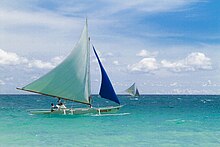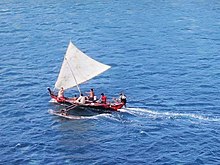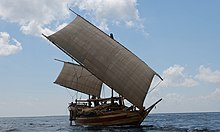Outrigger (nautical)
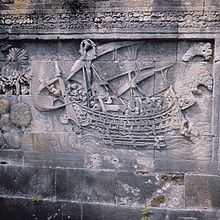

Anoutriggeris a projecting structure on a boat, with specific meaning depending on types of vessel. Outriggers may also refer to legs on a wheeled vehicle that are folded out when it needs stabilization, for example on acranethat lifts heavy loads.
Powered vessels and sailboats
[edit]An outrigger describes any contraposing floatriggingbeyond the side (gunwale) of a boat to improve the vessel's stability. If a single outrigger is used it is usually but not alwayswindward.[1][why?]The technology was originally developed by theAustronesian people.There are two main types of boats with outriggers: double outriggers (prevalent inmaritime Southeast Asia) and single outriggers (prevalent inMadagascar,Melanesia,MicronesiaandPolynesia).Multihullships are also derived from outrigger boats.[2]
In anoutrigger canoeand insailboatssuch as theproa,an outrigger is a thin, long, solid,hullused to stabilise an inherently unstable main hull. The outrigger is positioned rigidly and parallel to the main hull so that the main hull is less likely tocapsize.If only one outrigger is used on a vessel, itsweightreduces the tendency to capsize in one direction and itsbuoyancyreduces the tendency in the other direction.
On akeelboat,"outrigger" refers to a variety of structures by which therunning rigging(such as asheet) may be attached outboard (outside the lateral limits) of the boat'shull.TheRacing Rules of Sailinggenerally prohibit[3]such outriggers, though they are explicitly permitted on specific classes, such as theIMOCA Open 60[4]used in several major offshore races.
Fishing
[edit]Infishingfrom vessels, an outrigger is a pole or series of poles that allow boats to trawl more lines in the water without tangling and simulates a school of fish.
Rowing
[edit]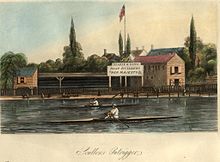
In arowingboat orgalley,an outrigger (or rigger) is a triangular frame that holds therowlock(into which theoaris slotted) away from the saxboard (or gunwale ingig rowing) to optimize leverage. Wooden outriggers appear on the newtriremearound the 7th or 6th centuries BC and later on Italian galleysaround AD 1300,whileHarry Clasper(1812–1870), aBritishprofessional rower, popularised the use of the modern tubular-metal version and the top rowing events accepted the physiological and ergonomic advantages so acceded to its use in competitions. In recent decades, some manufacturers ofracing shellshave developedwing-riggerswhich are reinforced arcs or flattened tubular projections akin to aircraft wings, instead of conventional triangular structures.
See also
[edit]References
[edit]- ^Early Ships and Seafaring: Water Transport Beyond Europe;Sean McGrail; Glossary
- ^Texas, Edwin Doran Jr. (1974)."Outrigger ages".The Journal of the Polynesian Society.83(2): 130–140.
- ^"The Racing Rules of Sailing 2017-2020"(PDF).Retrieved2016-11-12.
- ^"Class Rules - IMOCA 60 (Open 60 Monohull)"(PDF).Retrieved2016-11-12.



